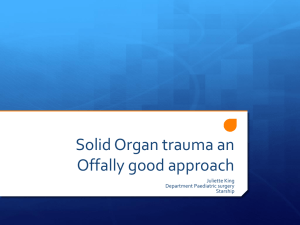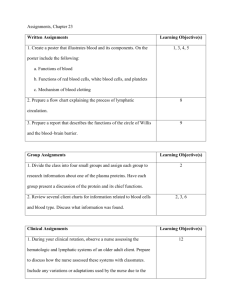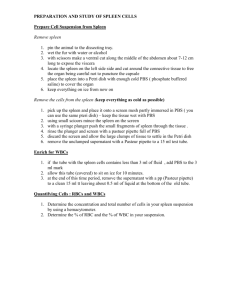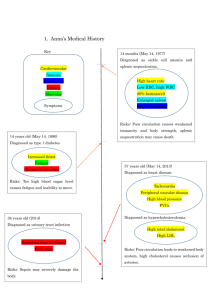Splenectomy in trauma patients is associated with an increased risk
advertisement
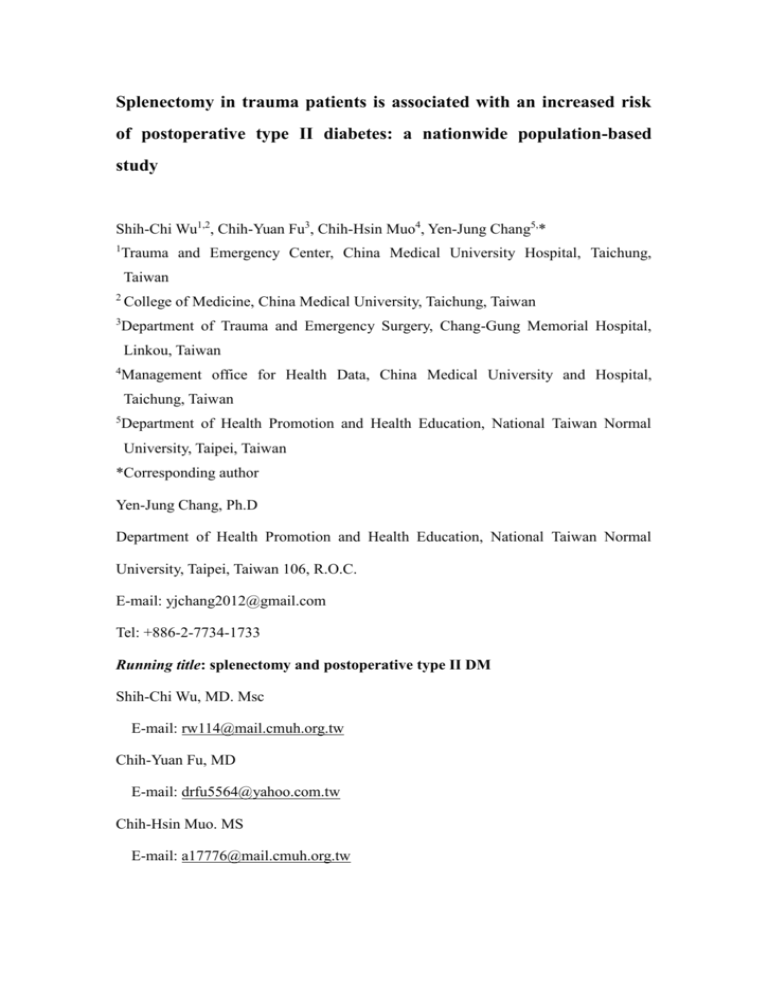
Splenectomy in trauma patients is associated with an increased risk of postoperative type II diabetes: a nationwide population-based study Shih-Chi Wu1,2, Chih-Yuan Fu3, Chih-Hsin Muo4, Yen-Jung Chang5,* 1 Trauma and Emergency Center, China Medical University Hospital, Taichung, Taiwan 2 College of Medicine, China Medical University, Taichung, Taiwan 3 Department of Trauma and Emergency Surgery, Chang-Gung Memorial Hospital, Linkou, Taiwan 4 Management office for Health Data, China Medical University and Hospital, Taichung, Taiwan 5 Department of Health Promotion and Health Education, National Taiwan Normal University, Taipei, Taiwan *Corresponding author Yen-Jung Chang, Ph.D Department of Health Promotion and Health Education, National Taiwan Normal University, Taipei, Taiwan 106, R.O.C. E-mail: yjchang2012@gmail.com Tel: +886-2-7734-1733 Running title: splenectomy and postoperative type II DM Shih-Chi Wu, MD. Msc E-mail: rw114@mail.cmuh.org.tw Chih-Yuan Fu, MD E-mail: drfu5564@yahoo.com.tw Chih-Hsin Muo. MS E-mail: a17776@mail.cmuh.org.tw Acknowledgements This study was supported by the Taiwan Department of Health Clinical Trial and Research Center for Excellence (DOH102-TD-B-111-004) and the Taiwan Department of Health Cancer Research Center for Excellence (DOH102-TD-C-111-005). Dr. Yen-Jung Chang is the guarantor of this work and, as such, has full access to all data in the study and takes responsibility for the integrity of the data and the accuracy of the data analysis. Shih-Chi Wu contributed to the study design and wrote the manuscript. Chih-Yuan Fu researched the data and reviewed the manuscript. Chih-Hsin Muo researched the data and wrote the manuscript. Yen-Jung Chang contributed to the study design and reviewed/edited the manuscript. All authors declare that they have no conflicts of interest. Abstract Background: Animal studies indicate that splenocytes may act as precursors of β-islet secretory cells in the pancreas. This study aimed to assess the risk of postoperative type II diabetes after splenectomy in trauma patients. Methods: We used data from Taiwan National Health Insurance hospitalized claims. Study 1 included 3723 patients receiving splenectomy and 3723 matched patients receiving other types of abdominal surgery. Study 2 included 5996 patients with spleen injury and 5996 matched patients with other types of abdominal injury. The hazard ratio for diabetes was estimated using the matched Cox proportional hazard regression model. Results: In trauma patients after surgery, those who received splenectomy had a 2.00-fold higher risk of diabetes compared to patients without splenectomy after a 3-year follow-up period. In the non-operative group, there was no difference in diabetes risk between patients with splenic injury and those with other types of injury. Conclusions: Splenectomy was associated with an increased risk of postoperative type II diabetes in trauma patients. Thus, there may be a role for the spleen in the development of diabetes. Introduction The spleen is known to play an important role in both immune and circulatory functions. Reports have also suggested that the spleen may serve as a source of adult multipotent stem cells, which could act as precursors of β-islet secretory cells in the pancreas1,2. Moreover, clinical studies assessing the operative management for chronic pancreatitis have revealed that patients who received splenectomy with pancreatectomy developed post-operative diabetes at a higher rate than those who received spleen-preserving pancreatectomy 3,4. Furthermore, traumatic splenectomy has been associated with hyperglycemia after long-term follow up5, which indicates that there might be an association between splenectomy and the development of post-operative adult onset diabetes. Trauma patients may represent an appropriate study population for investigating the association between splenectomy and postoperative diabetes because trauma patients receiving splenectomy are distinct from those who receive splenectomy due to hematological diseases. To assess the effect of splenectomy on post-operative diabetes in trauma patients, we conducted this nationwide population-based cohort study using the Taiwan Longitudinal Health Insurance Database and hypothesized that splenectomy would be associated with a higher incidence of postoperative diabetes. Materials and Methods Method Data source The Taiwan National Health Insurance program was set up by the Bureau of Health Insurance in 1995, and this program has covered over 99% of the entire population in Taiwan. For research use, the National Health Research Institutes set up the Longitudinal Health Insurance Database in 2000 (LHID2000), which contains one million randomly selected subjects from the registry for beneficiaries in 2000 and includes all of these patients’ medical claims from 1996 to 2010. For the privacy protection of patients, the identification information was scrambled cryptographically before the data were released for research use. This study was approved by the ethical review board of China Medical University in Taiwan. Study population We selected 15,462 patients with newly diagnosed spleen injury (SI, International Classification of Diseases, 9th Revision, Clinical Modification [ICD-9-CM] 865) between 1998 and 2010 from the hospitalization records, and we defined the diagnosis date of spleen injury as the entry date. Subjects demonstrating a history of diabetes mellitus (DM, ICD-9-CM 250, n=5,175) before the entry date, those with other types of abdominal surgery (ICD-9-CM 863 and 864; treatment code 45.9, 50, and 54, n=249) and those who received splenectomy with pancreatectomy (treatment code 52 and 41.5, n=314) prior to the occurrence of type II DM (ICD-9-CM 250.x0 and 250.x2) were excluded. Our study sample included a total of 9,719 patients with spleen injury, who were classified in the splenectomy group (N=3,723) or non-splenectomy group (N=5,996). The control group consisted of 30,413 patients with other types of abdominal injury (ICD-9-CM 863 and 864) who were diagnosed between 1998 and 2010, and the date of diagnosis was considered the entry date. We excluded 2,660 patients with a history of DM and 4,686 patients with spleen or pancreas injury prior to the occurrence of type II DM. The patients with other types of abdominal injury were grouped into surgery (N=8,018) and non-surgery groups (N=15,049). To identify the level of injury severity in these trauma patients, we considered major trauma as rated ≧ 16 in the Injury Severity Score (ISS). In Taiwan, patients who suffer from major trauma and score ≧ 16 receive a certificate from the National Health Insurance Program for waiver of the co-payment. We conducted individual matching for the study and control cohorts based on age, sex, and the presence of hypertension (ICD-9-CM 401-405) and hyperlipdemia (ICD-9-CM 270). There were 2 studies included in this manuscript. Study 1, which was designed for the surgery subjects, included 3,723 patients who received splenectomy and 3,723 matched patients who received other types of abdominal surgery. Study 2, which was designed for the non-surgery subjects, consisted of 5,996 patients with spleen injury and 5,996 matched patients with other types of abdominal injury. The flow chart displayed in figure 1 shows our sampling method. Statistical analysis The chi-square test and Wilcoxon test were used to test the categorical and continuous variables between the spleen injury (SI) and non-spleen injury (non-SI) cohorts in both studies. The study cohorts were followed from baseline to the occurrence of type II DM, withdrawal from the insurance program, or the end of 2010. The SI to non-SI hazard ratios (HRs) and 95% confidence intervals (95% CIs) for DM were estimated using matched Cox proportional hazard regression. We further divided the follow-up period into 3 time periods: within 1 year, 2-3 years, and more than 3 years. Kaplan-Meier analysis was used to generate the cumulative incidence of DM between the SI and non-SI cohorts. All statistical analyses were performed using SAS 9.1 software for Windows (SAS Institute, Cary, NC, USA), and the significance level was set at 0.05. Results Study 1 for surgical patients compared SI patients who received splenectomy to non-SI patients who received other types of abdominal surgery. The study subjects were dominated by males, and more than half of the patients receiving operations were older than 30 years of age. There were no significant differences in age, gender, follow-up years, or the prevalence of hypertension, hyperlipidemia and major trauma between patients with and without spleen injury (Table 1). The average follow-up time was 5.91 years and 5.96 years for the SI group and the non-SI group, respectively. After 13 years of follow up, the incidence rates of DM in the surgery group were 6.68 and 5.36 per 1000 person-years in patients with and without spleen injury, respectively (Table 3). After adjusting for all covariates, patients who received splenectomy had a 2.00-fold greater risk of diabetes compared to patients without splenectomy after a 3-year follow-up period (aHR= 2.00, 95% CI = 1.20-3.34). Among men and participants younger than 50 years of age, patients who received splenectomy also had a higher risk for DM (aHR = 1.89 in men; aHR = 1.79 in subgroup aged <50 years) Study 2 for non-surgical patients compared SI patients who did not receive surgery to non-SI patients who did not receive surgery. Among the non-surgical subjects, no differences in age, gender, study period or comorbidities were observed between the SI and non-SI cohorts (Table 2). The average follow-up time was 5.46 years and 5.30 years for the SI group and the non-SI group, respectively. Overall, the incidence rates of DM were 5.65 and 5.63 per 1000 person-years in the SI group and non-SI group, respectively (Table 3). We found no difference in the DM risk between SI and non-SI patients among patient subgroups with different follow-up durations. In addition, no difference in the incidence of developing diabetes was observed between patients with spleen injury and patients with other types of abdominal injuries (Fig. 2B). Discussion The spleen is known to play an important role in human immunity. Clinical observations indicate that patients who receive splenectomy with pancreatectomy are more likely to develop post-operative diabetes compared with those who receive spleen-preserving pancreatectomy3. Additionally, traumatic splenectomy has been associated with hyperglycemia after long-term follow up5. Furthermore, children who receive splenectomy for severe thalassaemia have been shown to have an increased incidence of glucose intolerance6. Therefore, the current evidence supports the association between splenectomy and type II DM. Our study findings indicated that patients who received splenectomy had a 2.00-fold greater risk of developing DM compared to patients without splenectomy after a 3-year follow-up period. This result suggests that splenectomy may be associated with an increased risk of postoperative diabetes after long-term follow up. The spleen is thought to harbor pancreatic stem cells, as cells within the spleen demonstrate close inter-relationships with stem cells during embryonic development7,8. In particular, it has been reported that the splenic mesenchyme buds off from the pancreatic mesenchyme during early development 9. Additional evidence for this close relationship between cell types came from a study that used PTF1-p48 gene knockout mice; although these mice are born without an exocrine pancreas, functional islets were found in the spleen and these animals showed normoglycemia10. In addition, it has been reported that human adult spleens uniquely possess a reservoir of multilineage adult stem cells that express the developmental transcription factor HOX11 11,12. HOX11 stem cells demonstrate low levels of lineage restriction and are essential for organogenesis of the spleen and the development of the pancreas, cochlea, hindbrain, and other organs12. Furthermore, a previous study proposed that spleen stem cells may act as precursors for β-islet secretory cells in the pancreas2. Specifically, these rodent studies revealed that splenocytes could enhance the neogenesis of pancreatic β-islet secretory cells 2, indicating that the spleen may play an important role in the endocrine function of the pancreas. Patients who receive other types of abdominal surgery (e.g., for bowel injury) rather than splenectomy may experience a similar degree of peri-operative stress, which may result in hormonal and/or metabolic changes as well as the development of diabetes. In the present study, we compared the risk of developing DM between both study groups that received surgery to evaluate whether receiving surgery affected the development of DM. Moreover, we assumed that there was no difference in surgical stress between the group receiving splenectomy and the group receiving other types of abdominal surgery. It is not uncommon to observe hyperglycemia after traumatic insults or in cases of critical illness. For example, diabetes in cases of critical illness may be attributed to acute insulin resistance13. Jiang S et al. reported that macrophages may play a role in maintenance of the insulin-resistant state and the development of critical illness diabetes in rodent model 14. Moreover, there is also evidence that hyperglycemia is predictive of outcome in critically ill trauma patients 15. However, this result was mostly indicative of the short-term, rather than long-term, effects of trauma and injury, indicating that the acute stress associated with trauma may not play a role in the development of hyperglycemia in long-term follow up patients. Therefore, we presumed that the development of postoperative diabetes after more than 3 years of follow up may have been due to removal of the spleen. The spleen is one of the most vulnerable solid organs in the abdominal cavity, and spleen injuries are managed using both surgical and non-surgical approaches16. As a result, the application of non-surgical management for spleen salvage in blunt splenic injury patients with hemodynamic stability has been widely accepted and has become a trend of standard treatment in recent decades. However, some centers still tend to perform surgeries for higher-grade splenic injuries17. Our present study indicated that splenectomy was associated with an increased risk of postoperative DM. Therefore, our findings may provide additional evidence supporting the non-operative approach for spleen salvage in the management of splenic injuries. It has been proposed that the development of type 2 diabetes mellitus (also termed adult-onset diabetes mellitus) may be due to islet replication declination with human ageing18. However, there remains a debate as to whether adult-onset diabetes mellitus is due to β-cells themselves or another tissue that may influence β-cell proliferation in a cell non-autonomous manner19. For example, Conboy IM et al. reported that cell non-autonomous factors may play a major role in the regulation of stem cell ageing in muscle systems20. It has also been suggested that the spleen could serve as a source of new islets for transplantation in children, which may demonstrate the potential to reverse diabetes21. Therefore, it is possible that removal of the spleen may disrupt the non-autonomous regulation pathway and increase the risk of adult-onset diabetes. It has been proposed that the central nervous system may regulate innate immune responses via the vagus nerve. Termed the cholinergic anti-inflammatory pathway, this mechanism involves vagus nerve stimulation followed by the inhibition of proinflammatory cytokine release22. Using an animal model, the study by Huston JM et al. suggested that the cholinergic pathway may be closely related to the spleen via the branching of the vagus nerve and indicated that splenectomy may inactivate the cholinergic pathway during endotoxemia and sepsis 23. These findings suggested that the spleen plays an important role in the inflammatory reflex or neuro-humoral control of inflammation mediated by the vagus nerve24. Therefore, future studies should examine the potential associations between long-term diabetes and the failure to inhibit proinflammatory cytokine production via the vagus nerve after splenectomy. To our knowledge, this was the first large cohort study to investigate the association between splenectomy and the development of DM using population data. However, we recognize several limitations of the current study, including its retrospective nature, modest sample size and the probable bias in case selection, which may have restricted our analytical conclusions. In addition, we acknowledge that the lack of data on risk factors such as obesity and smoking represents another limitation. Another flaw of this study was the paucity of data on short-term glycemic control near the time of surgery, in which stress hormone response (e.g., epinephrine, cortisol) may represent an important harbinger. Therefore, additional multi-institutional trials or randomized experimental studies should be performed with predefined enrollment criteria for a better understanding of this association and its mechanism. In conclusion, our study results showed that splenectomy in trauma patients is associated with a long-term increased risk of postoperative type II diabetes. This finding may be partially attributed to the role of the spleen in the endocrine function of the pancreas and as a mediator of neuro-humoral control. Future studies are warranted to investigate this proposed relationship and the underlying mechanisms. Additionally, our results may provide evidence in support of clinical spleen salvage for the management of splenic injuries. References 1. Faustman DL, Davis M. Stem cells in the spleen: Therapeutic potential for Sjogren’s syndrome, type I diabetes, and other disorders. Int J Biochem Cell Bio, 2010; 42:1576-9. 2. Park S, Hong SM, Ahn IS. Can splenocytes enhance pancreatic β-cell function and mass in 90% pancreatectomized rats fed a high fat diet? Life science, 2009; 84: 358-63. 3. S. Govil, C.W. Imrie Value of splenic preservation during distal pancreatectomy for chronic pancreatitis. Br J Surg, 1999; 86:895-8. 4. R.R. Hutchins, R.S. Hart, M. Pacifico, et al. Long-term results of distal pancreatectomy for chronic pancreatitis in 90 patients. Ann Surg, 2002; 236:612-8. 5. Ley EJ, Singer MB, Clond MA, et al. Long term effect of trauma splenectomy on blood glucose. J Surg Res, 2012 ;177:152-6 6. B.W. Lee, S.H. Tan, W.K. Lee, et al. Glucose tolerance test and insulin levels in children with transfusion-dependent thalassaemia. Ann Trop Paediatr, 1985; 5:215-8. 7. S. Kodama, M. Davis, D.L. Faustman. Diabetes and stem cell researchers turn to the lowly spleen. Sci Aging Knowledge Environ, 2005;2005:p2 8. Hörnblad A, Eriksson AU, Sock E, et al. Impaired spleen formation perturbs the morphogenesis of the gastric tubes of the pancreas during development. PLoS One, 2011; 6: e21753 9. A. Asayesh, J. Sharpe, R.P. Watson, et al. Spleen versus pancreas: strict control of organ interrelationship revealed by analyses of Bapx1−/− mice. Genes Dev, 2006;20:2208-13 10. A. Krapp, M. Knöfler, B. Ledermann, et al. The bHLH protein PTF1-p48 is essential for the formation of the exocrine and the correct spatial organization of the endocrine pancreas. Genes Dev, 1998; 12:3752-63. 11. Dieguez-Acuna FJ, Gygi SP, Davis M, et al. Splenectomy: a new treatment option for ALL tumors expressing Hox-11 and a means to test the stem cell hypothesis of cancer in humans. Leukemia, 2007; 21:2192-4.. 12. Lonyai A, Kodama S, Burger D, et al. The promise of Hox11+ stem cells of the spleen for treating autoimmune diseases. Horm Metab Res, 2008; 40:137-46. 13. Bonizzoli M, Zagli G, Lazzeri C, et al. Early insulin resistance in severe trauma without head injury as outcome predictor? A prospective, monocentric pilot study. Scand J Trauma Resusc Emerg Med. 2012; 20: 69. 14. Jiang S, Gavrikova TA, Sharifov OF, Messina JL. Role of tissue macrophage in the development of critical illness diabetes. Shock, 2012; 37:70-6. 15. Bochicchio GV, Sung J, Joshi M, et al. persistent hyperglycemia is predictive of outcome in critically ill trauma patients. J Trauma, 2005; 58:921-4. 16. Savage SA, Zarzaur BL, Magnotti LJ, et al. The evolution of blunt splenic injury: resolution and progression. J Trauma, 2008;64:1085-91 17. Davis KA, Fabian TC, Croce MA, et al. Improved success in nonoperative management of blunt splenic injuries: embolization of splenic artery pseudoaneurysms. J Trauma, 1998 ;44:1008-13 18. Butler AE, Janson J, Bonner-Weir S, et al. Beta-cell deficit and increased beta-cell apoptosis in humans with type 2 diabetes. Diabetes, 2003; 52:102-10. 19. Sharpless NE, DePinho RA. How stem cells age and why this makes us grow old Nat Rev Mol Cell Biol, 2007 ;8:703-13 20. Conboy IM, Conboy MJ, Wagers AJ, et al. Rejuvenation of aged progenitor cells by exposure to a young systemic environment. Nature, 2005;433:760-4 21. Robertson SA, Rowan-Hull AM, Johnson PR. The spleen--a potential source of new islets for transplantation. J Pediatr Surg, 2008 ;43:274-8 22. Huston JM. The vagus nerve and the inflammatory reflex: wandering on a new treatment paradigm for systemic inflammation and sepsis. Surg Infect (Larchmt), 2012; 13:187-93. 23. Huston JM, Wang H, Ochani M, et al. Splenectomy protects against sepsis lethality and reduces serum HMGB1 levels. J Immunol, 2008; 181:3535-9. 24. Rosas-Ballina M, Ochani M, Parrish WR, et al. Splenic nerve is required for cholinergic antiinflammatory pathway control of TNF in endotoxemia. Proc Natl Acad Sci U S A, 2008; 105:11008-13. Legends Table 1. Demographics of spleen injury patients and non-spleen injury patients in the surgery group (study 1) Table 2. Demographics of spleen injury patients and non-spleen injury patients in the non-surgery group (study 2) Table 3. Incidence and hazard ratio of DM for spleen injury patients and non-spleen injury patients, stratified by sex, age, and follow-up duration Figure 1. Flow chart showing the study subject selection process Figure 2. Cumulative incidence of type II DM for (A) study 1 and (B) study 2 Table 1. Demographics of spleen injury patients and non-spleen injury patients in the surgery group (study 1) With surgery Spx Non-spx N=3723 N=3723 n Age, years <30 30-49 ≥ 50 Mean (SD) Male Follow-up, yr, Mean (SD) Comorbidity Hypertension Hyperlipidemia Major trauma# % n % p-value > 0.99 1773 1125 825 35.8 47.6 30.2 22.2 (18.0) 1773 1125 825 35.6 47.6 30.2 22.2 (18.0) 0.84† 2719 5.91 73.0 (3.95) 2719 5.96 73.0 (3.75) > 0.99 0.82† 120 52 460 3.22 1.40 12.4 120 52 460 3.22 1.40 12.4 > 0.99 > 0.99 > 0.99 Spx: splenectomy, Chi-square test, Spx group compared to Non-spx group †Wilcoxon test, Spx group compared to Non-spx group # Major trauma: Injury severity score rated ≥ 16 Table 2. Demographics of spleen injury patients and non-spleen injury patients in the non-surgery group (study 2) Without surgery SI N=5996 Non-SI N=5996 n Age, years <30 30-49 ≥ 50 Mean (SD) Male Follow-up, yr, Mean (SD) Comorbidity Hypertension Hyperlipidemia Major trauma# % n % p-value > 0.99 3145 1690 1161 33.4 4248 52.5 28.2 19.4 (18.0) 70.9 3145 1690 1161 33.3 4248 52.5 28.2 19.4 (18.8) 70.9 0.96† > 0.99 5.46 (3.75) 5.30 (3.75) 0.01† 195 81 432 3.25 1.35 7.20 195 81 432 3.25 1.35 7.20 > 0.99 > 0.99 > 0.99 SI: spleen injury, Chi-square test, SI group compared to the non-SI group †Wilcoxon test, SI group compared to the non-SI group # Major trauma: Injury severity score rated ≥ 16 Table 3. Incidence and hazard ratio of DM for spleen injury patients and non-spleen injury patients, stratified by sex, age, and follow-up duration Study 1 (surgical group) Spx Overall Sex Male Female Age, years <50 >=50 Follow-up <=1 year 2-3 year > 3 year Study 2 (non-surgical group) Non-spx Case IR Case IR 147 6.68 119 112 35 6.99 5.84 76 71 27 36 84 SI Non-SI HR (95% CI) Case IR Case IR 5.36 1.59 (1.13-2.24)** 185 5.65 179 5.63 0.98 (0.75-1.29) 79 40 4.90 6.55 1.89 (1.26-2.83)** 1.00 (0.52-1.92) 136 49 5.88 5.10 145 34 6.44 3.67 0.96 (0.70-1.32) 1.04 (0.60-1.80) 4.14 19.33 56 63 3.05 16.43 1.79 (1.12-2.84)* 1.39 (0.84-2.29) 105 80 3.82 15.29 81 98 3.04 19.24 1.23 (0.84-1.80) 0.77 (0.52-1.14) 8.08 6.22 6.52 19 21 79 6.00 3.77 5.86 1.40 (0.72-2.72) 1.24 (0.65-2.34) 2.00 (1.20-3.34)** 32 43 110 5.82 4.66 6.11 34 45 100 6.26 4.98 5.78 0.94 (0.56-1.55) 0.82 (0.57-1.47) 1.08 (0.69-1.68) Spx: splenectomy, IR, incidence rate, per 1000 person-years, SI: spleen injury Adjusted for age, gender, hypertension, hyperlipidemia and major trauma HR (95% CI) NHIRD inpatient database 15462 patients hospitalized with spleen injury (SI) from 1998-2010 30413 patients hospitalized with other abdominal trauma from 1998-2010 Excluded 5175 patients with a history of DM and 563 patients with other abdominal injuries (including 314 patients receiving pancreatectomy with splenectomy) before the study end point Excluded 2660 patients with a history of DM and 4686 patients with SI or pancreas injury before the study end point 9724 patients with SI 5999 patients without splenectomy 23067 patients with other abdominal injury 3725 patients with splenectomy 8018 patients with surgery 15049 patients without surgery 1:1 Individual matched (Study 1: patients with surgery) 1:1 Individual matched (Study 2: patients without surgery) 3723 abdominal injury 3723 SI patients 5996 abdominal injury 5996 SI patients patients with surgery (Non-Spx group) with splenectomy (Spx group) patients without surgery (Non-SI group) without splenectomy (SI group) Figure 1. Flow chart showing the study subject selection process Figure 2. Cumulative incidence of type II DM in (A) study 1 and (B) study 2


